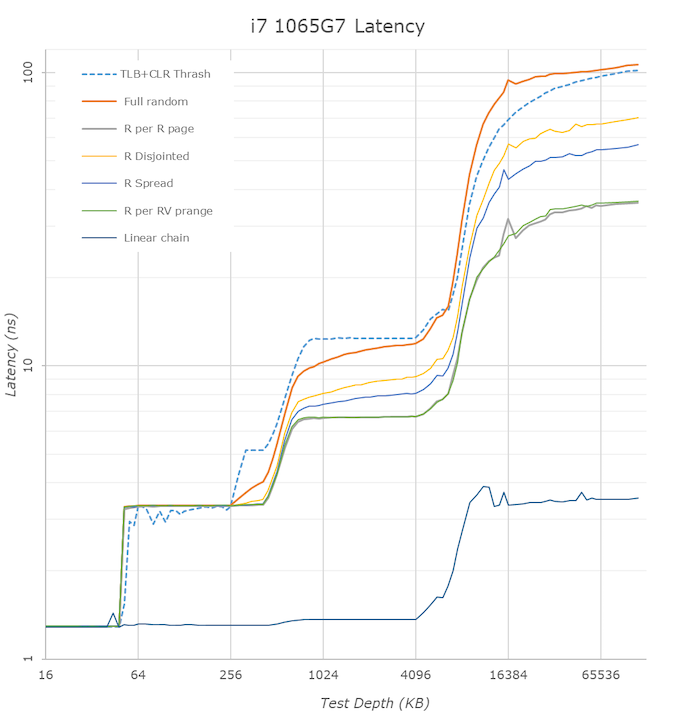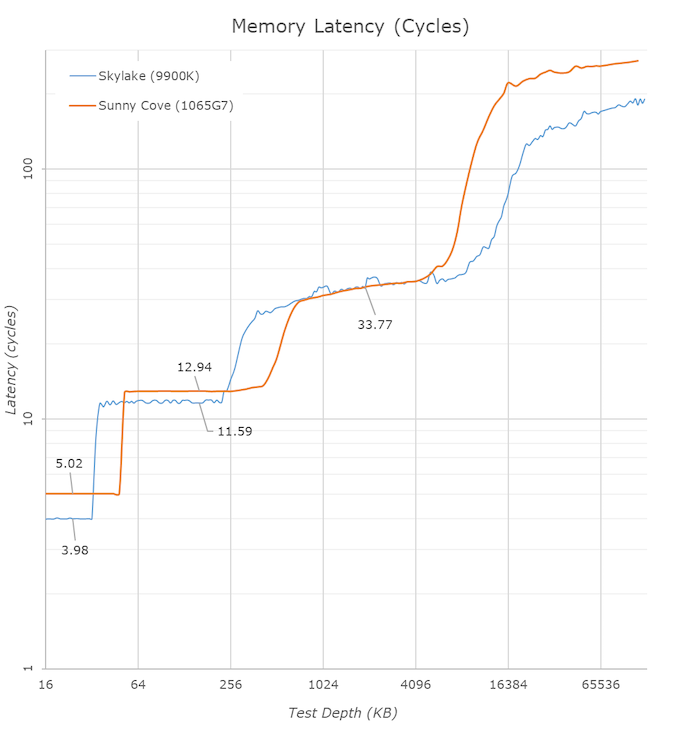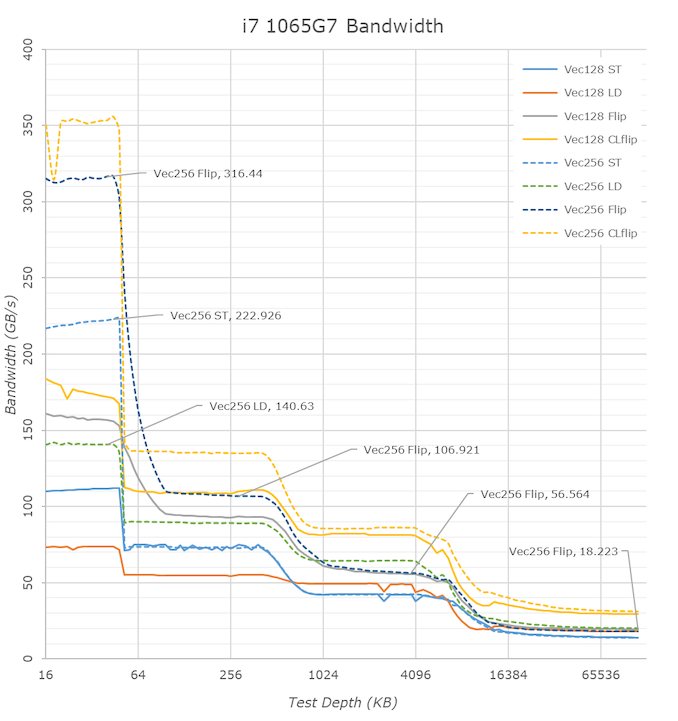The Ice Lake Benchmark Preview: Inside Intel's 10nm
by Dr. Ian Cutress on August 1, 2019 9:00 AM EST- Posted in
- CPUs
- Intel
- GPUs
- 10nm
- Core
- Ice Lake
- Cannon Lake
- Sunny Cove
- 10th Gen Core
Cache and TLB Updates
One of the biggest changes in the new Sunny Cove core is the cache hierarchy. Throughout most of the last decade, Intel has kept the same cache configuration among its server cores with very few changes, aside from improving the micro-op cache through Sandy Bridge today, but with Sunny Cove, we get some key updates.
From our microarchitecture disclosure article, we know that Sunny Cove brings with it an increased L1 data cache, as well as a doubled L2 cache, from Skylake. With this comes more associativity as well.
| Core Cache Comparison | ||||||
| Sunny Cove |
AnandTech | Cannon Lake |
Skylake | Sandy Bridge |
AMD Zen 2 |
|
| 48 KB 12-way |
L1-D | 32 KB 8-way |
32 KB 8-way |
32 KB 8-way |
32 KB 8-way |
|
| 32 KB 8-way |
L1-I | 32 KB 8-way |
32 KB 8-way |
32 KB 8-way |
32 KB 8-way |
|
| 512 KB 8-way |
L2 | 256 KB 4-way |
256 KB 4-way |
256 KB 8-way |
512 KB 8-way |
|
| 2 MB 16-way |
L3/core | 2 MB 16-way |
2 MB 16-way |
2MB 16-way |
4 MB 16-way |
|
| 2304 | uOp Cache | 1536 | 1536 | 1536 | 4096 | |
I’ve also included the size of the micro-op cache in this comparison, because we understand that the L1-I and the micro-op cache are typically located next to each other in the die design – increasing the size of one typically means limiting the size of the other, however given that both of them work to accelerate the same types of data, it is important to find the right balance: AMD for Zen 2 decided to halve the L1-I and double its associativity, and then double the micro-op cache from 2k to 4k entries. For Sunny Cove, Intel has increased the L1-D by 50%, but also increased the micro-op cache by 50%, taking advantage of the second generation 10nm process.
In the above latency graph comparison, we can notably see the new increased cache capacities. The L1’s increase from 32KB to 48KB is well visible, as well as the L2 increase from 256KB to 512KB.
On the part of the L2 it’s interesting to see that again the new core’s TLB structures don’t quite cover the whole capacity of the L2 and that’s why the latter half of the L2 has worse access latencies for L1D TLB miss patterns.
L3 latencies look similar, however we’ll dwell into that just in a bit. The DRAM latencies of course are apples and oranges in this case as Intel’s new LPPDR4X memory controller in the new ICL part doesn’t have a counter-part we can compare to, but as expected the memory latency is notably worse than a desktop part so no big surprises there.
What’s rather disappointing however is that we’re not really seeing any kind of change to the prefetchers and our access patterns between the two microarchitectures look identical. We had expected Intel to improve in this regard, but alas it seems, at least for our test cases, there’s been no improvements.
One of the major balancing acts with cache sizes is also cache latency. The bigger the cache, the longer it takes to retrieve data from it – increasing associativity can do this as well. Intel for the longest time has cited a 4-cycle latency to its L1 cache, and a 12-cycle latency to its L2 cache. This changes, in quite a substantial way.
| Core Cache Latency (in cycles) | ||||||
| Sunny Cove | AnandTech | Cannon Lake |
Skylake | Sandy Bridge |
AMD Zen 2 |
|
| 5 | L1 | 4 | 4 | 4 | 4 | |
| 13 | L2 | 12 | ~12 | 12 | 12 | |
| 30-36 | L3 | 26-37 | 34 | |||
Due to the increase in the L1 cache, that 4-cycle latency is now a 5-cycle latency. Intel is hoping that its double L1 store bandwidth will help hide that latency, however adding 20% latency onto every data fetch is a heavy hit to take. This is why a lot of the rest of the core is also beefed up, so work can still continue to cover for this extra cycle. It is worth noting that Intel’s Atom cores in the past had an L1 latency of 3 cycles, however they have also since moved to 4-cycle.
The L2 also changes, from 12 cycles to 13 cycles. You can’t double a cache for free, and it is interesting to note here that now AMD and Intel share the same L2 cache size and the same associativity, however AMD has a cycle advantage on Intel. This has a knock on effect for L3 cache latency too, which has increased from ~26-37 cycles to ~30-36 cycles on Intel, from Skylake. The latency here isn’t uniform because the cache isn’t uniform, and accessing non-local L3 slices comes with a latency penalty, as say opposed to AMD’s uniform latency L3.
One of the biggest additions Intel was keen to make in our Sunny Cove microarchitecture disclosure is the increase in the L1 bandwidth. Based on our testing, Skylake’s L1 data cache was capable of 2x32-byte read and 1x32-byte write per clock. For Sunny Cove this has increased, but it gets a bit more complicated. In one clock Sunny cove can perform 2x64-byte reads and either 1x64-byte write, or 1x32-byte write, or 2x16-byte writes. So both reads and writes, at peak, have doubled with bit width, with the write configurations being a bit more complex.
We can see the direct effects of the bandwidth change in our bandwidth tests. The L1 store bandwidth is extremely evident as it measures in at 222GB/s on the ICL part, while only reaching 139GB/s on the 28% higher clocked 9900K. If we normalise for frequency, we indeed see a doubling of the store bandwidth of the new core.
The L2 cache bandwidth looks unchanged from Skylake – the part here lags behind with an equal amount to the frequency difference. Surprisingly, the L3 bandwidth fares quite well here and is almost at parity to the desktop 9900K even though the frequency difference. The DRAM bandwidth is inferior on the ICL mobile chip, but again that’s to be expected due to the apples and oranges DRAM architecture comparison.
Moving on to the TLB configurations, and it turns out that Intel has moved where this data is stored. This data is typically stored in CPUID.02h, however it is now found in CPUID.18h, and the info between different page sizes and capabilities is now given as subdivisions. The TLBs look as follows, and broken down into configurations:
| Sunny Cove TLB | |||
| AnandTech | Type | Entries | Associativity |
| L1-D | 4K | 64 | 4-way |
| L1-D | 2M | 32 | 4-way |
| L1-D | 1G | 8 | full |
| L1-I | 4K+2M | 8 | full |
| L1-I | 4K+2M+1G | 16 | full |
| L2 | 4K+2M | 1024 | 8-way |
| L2 | 4K+1G | 1024 | 8-way |
This means that for 4K and 2M L1-I entries, there are a total 8+16 = 24 possible, but only 16 1G possible. For 4K L2 entries, there are 1024 + 1024 = 2048 entries possible, however only 1024 each of 2M/1G are possible. The peak numbers align with what Intel has told us in our microarchitecture disclosure, however it is good to dive into what is possible.













261 Comments
View All Comments
Phynaz - Saturday, August 3, 2019 - link
And it’s “than” not “then”. Perhaps your lack of grammar is part of your problem.Korguz - Saturday, August 3, 2019 - link
um ya ok sure.. anything you say...HStewart - Thursday, August 1, 2019 - link
Is useless to argue with AMD fans - they first state that 10nm is old fashion and that claims of 30% is based on 2015 Sky Lake cpus and when they find out it based on 8th generation they don't believe and then state G{U is not good enough. And that AVX 512 does not matter, bug Siggraph 2019 is going to change that.But people forget about the past, yes AMD did it 64 bit back in the older days when nobody care much about greater than 4G memory. They build memory management and we had the frequency wars with Pentium 4 days - but Intel came back with I Series and change ever. Past is be repeated again. But this time is the core wars but Ice Lake is beginning of iSeries like in those days.
Please keep in mind this is only the low power cpus that Intel has release - it only the top of iceburg.
HStewart - Thursday, August 1, 2019 - link
"G{U is not good enough. And that AVX 512 does not matter, bug Siggraph 2019"I wish we could edit, I am older so my eyes are not as good
"GPU is not good enough. And that AVX 512 does not matter, but SigGraph 2019"
Korguz - Thursday, August 1, 2019 - link
and its just a useless to argue with intel fans, right HStewart ?? you know 1st hand about that, as you are well known now to praise intel any chance you get, and seemingly forget the negative things intel has one over the years, especially the ones that cost intel a few billion dollars...HStewart - Friday, August 2, 2019 - link
Lets just keep Intel articles to Intel only and AMD articles to AMD only - not of this fan boy BS, I support Intel primary because the AMD fans are so rude to Intel supports and I will never support them because of that. I do change, I use to support only Apple and hated Android - but I change on that one primary because I saw that Apple was not changing it UI and that they require developer tools on Mac's. I not actually Intel fan, Intel user and Intel developer - that is different. I have 30 years development experience.jospoortvliet - Friday, August 2, 2019 - link
You know, nobody cares about your ‘support’. If you mean your support to help intel - it merely serves to make it look pathetic. If you have nothing intelligent to offer besides your ‘support’, whichever brand or product it is to benefit, you better just stay out of the conversation as that would improve its average quality substantially.I’m sure there are sites where comments from brand- supporting fans are appreciated. I sure as hell don’t read the comments here for that reason but to get insights and your comments just serve to make that harder as i need to weed through countless pointless conversations which involve you ‘supporting’ intel by lowering the collective intelligence of all readers here. Do everyone a favor and leave.
Korguz - Friday, August 2, 2019 - link
your are hilarious HStewart, maybe you should take your OWN advice for once.. oh wait.. you CAN'T cause you cant deal with the fact that intel isnt doing as good as it was before zen came out. when you stop with the intel fanboy BS, then maybe the rest of us will as well. no, you support intel cause you are a fanatic when it comes to them. " I not actually Intel fan " BS complete BS, and you have proved over AND over again, you are an intel fan.30 years of experience ?? BS, you dont know the DIFFERENCE between WATTS and VOLTS, and you KEEP spelling architeCture WRONG
Qasar - Friday, August 2, 2019 - link
" they first state that 10nm is old fashion and that claims of 30% is based on 2015 Sky Lake cpus and when they find out it based on 8th generation they don't believe " who is they ?? to be fair HStewart, most of intels iGP, were best suited for any thing that isnt games that arent played on facebook, or games that are a few years old, and office work. but looks like intel is trying to improve that :-)" yes AMD did it 64 bit back in the older days when nobody care much about greater than 4G memory " i can remember a few people wanting to be able to use more then 4 gigs of ram in their comps, with out having to go to server platforms, i was one of them, and a few of my friends did too.
" Please keep in mind this is only the low power cpus that Intel has release " from what i have read, seems like this is all intel can do with their current 10nm process right now, looks like intel, like with the desktop, thinks quad cores are " good enough ", cause if it isnt, why are these only quad core ? why not up the ante to 6 cores ? i guess, like the desk top, we have to wait to see if amd will do this...
RSAUser - Friday, August 2, 2019 - link
AVX512 really doesn't matter as I would find it strange for people to run such workloads on their laptops rather than on dedicated machines with way more processing power.For the common man, AVX512 does nothing though, but we can argue that most of the performance improvements don't really matter, I'm still using a device 5 years old with an i7 4720HQ and I feel no need to upgrade, only thing I am let down by is the graphics card (960M).
Intel will have a hard time convincing people to upgrade for this stuff before their machines basically keel over.